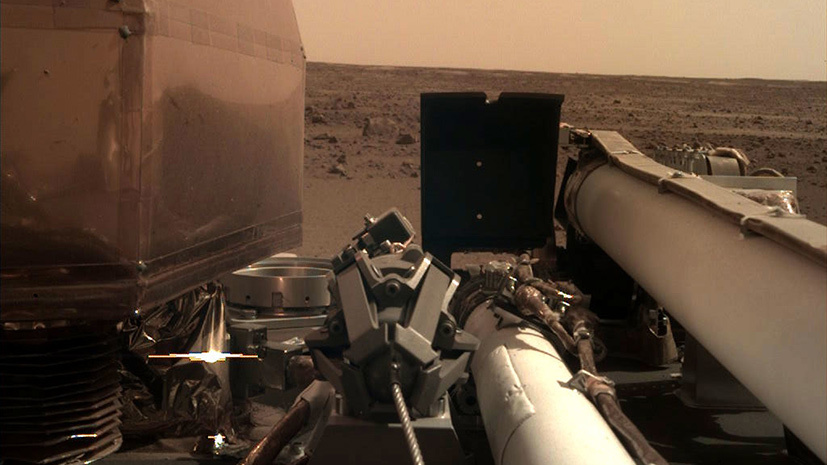The international team of geologists for the first time released data on the seismic activity of Mars, which were obtained by the InSight automatic interplanetary station. This was reported in the journal Nature Geoscience.
The mission of the InSight automatic interplanetary station, created by scientists from the United States, Germany and France, began on May 5, 2018. After a successful landing on Mars on November 26 of the same year, InSight began to study the internal structure and composition of the Red Planet. In a seismic experiment to study the internal structure of Mars, scientists investigated its geological activity and soil vibrations. Recall that the first “marsquake” was recorded in April 2019.
“We first got a real idea of the geological processes and the internal structure of Mars. This information helps to better understand the processes occurring on the planet, as well as the degree and place of seismic activity, ”said one of the authors of the work, a teacher at the Department of Geology at the University of Maryland, Nicholas Schmerr.
InSight station seismic sensors recorded 174 seismic events in 235 Martian days. Of these, 150 "marsquakes" were high-frequency. Oscillations of the surface with the same frequency were noted earlier on the moon. The other 24 phenomena were low-frequency. Their frequency is comparable to that which occurs during the movements of tectonic plates on Earth.
“Low-frequency vibrations are of particular interest because we know how to analyze them in order to extract information about the subsurface structure. By the way different waves pass through the crust (planets. - RT ), we can establish its geological layers, determine the distance to the source of vibrations and its location, ”said another study author, professor of the Department of Geology of the University of Maryland, Vedran Lekic.
- Marsquake waves detected by InSight sensors
According to scientists, understanding the essence of Martian seismic processes will answer the question - can Mars support life and has it ever supported it.
“Imagine such zones on Earth as hydrothermal sources of deep-sea ocean ridges, where the energy for life is provided not by solar heat, but by chemical processes. If liquid magma is found on Mars and we can determine the points of greatest seismic activity, the following missions can be aimed at finding the possibility of the existence of life, ”said Nicholas Schmerr.
The detection of signs of life on Mars was the main task of the Viking-1 and Viking-2 probes launched on the Red Planet in the 70s of the last century. Each of these devices was also equipped with seismometers, but they were installed directly on the ships and could not record the seismic activity of Mars.
The InSight station is equipped with a robotic arm, which was able to place the SEIS seismometer on the Martian surface at some distance from the landing site to isolate the sensors from interference from the spacecraft. SEIS is able to distinguish between very weak ground vibrations, which are 500 times weaker on Mars than the corresponding vibrations in the quietest places on Earth.
- InSight mission will last until the end of 2020
- NASA
The seismometer also provided important information on Martian weather. SEIS recorded strong winds and made it possible to compose daily cycles of surface activity near the landing site.
Researchers found that the wind intensified from around midnight until early in the morning. The winds reach their peak in the late afternoon, when atmospheric pressure drops. By evening, they subside. From late evening until midnight, atmospheric conditions are most favorable for fixing the seismic vibrations of Mars.
All earthquakes were noted during quiet night periods. At the same time, scientists believe that seismic activity persists during the Martian day, but atmospheric phenomena prevent it from being recorded.
“These data give us this beautiful picture of what day is really like on another planet,” said Lekic.
The InSight mission will last until the end of 2020.

